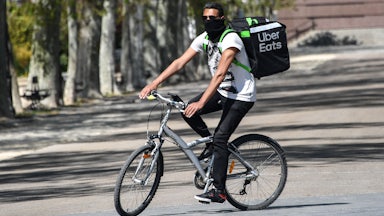If you listen to the sophistry emanating from corporate leaders and their stenographers in the business press, prices for goods and services are surging, and one of the causes is quite simple: Workers want more money. Following the shareholder’s logic, modest increases in worker pay—their demand for a living wage—must be “passed on” to the consumer. And so, as a spate of headlines this week now remind us, a Chipotle burrito now costs 4 percent more than it did last week.
Linking rising prices to workers’ demands for better wages is becoming a widely used trope. “From the cereal maker General Mills to Chipotle Mexican Grill to the paint maker Sherwin-Williams, a range of companies have been raising prices or plan to do so, in some cases to make up for higher wages that they’re now paying to keep or attract workers,” Marketplace reported on Thursday. While consumer demand is returning, workers aren’t, so restaurants are raising wages, not because most workers haven’t had a raise against inflation in 40 years, but because it’s a way of getting workers back in the door, despite potentially hazardous Covid-19 and more familiar crappy job conditions.
These headlines are about assigning blame: Your lunch just got more expensive thanks to the guy behind the counter. As a result, the framing implies, people should resent workers for demanding wage increases—not to mention an increase in the minimum wage to $15 or more. (This role reversal of misapplied sympathy even extends to business owners, who threaten that higher wages will force them to lay off workers, thereby tamping down worker activism.) Simple economic cause and effect, apparently. These headlines warn the reader, in other words, that every choice has a cost. And that’s true, it’s just that we’re talking about the wrong ones.
It helps, then, to expand the aperture and take a look at how some of these companies are husbanding their vast resources. Chipotle is doing very well, making more than $350 million in profit last year, matching a similarly profitable 2019. In 2020, Chipotle’s CEO was paid $38 million, but that’s only part of the picture. In recent years, the fast-casual burrito chain, like many large companies, has conducted hundreds of millions of dollars in share buybacks, which are used to juice a firm’s stock price, often to the benefit of executives exercising their own stock options. And a recent Securities and Exchange Commission filing shows that, in the first three months of 2021, its labor costs actually decreased by 10.2 percent. (Chipotle also benefited from “lower avocado pricing,” it noted in a release.)
As Congressman Ro Khanna said on Twitter, commenting on the company’s CEO pay, “Chipotle is not raising prices because of rising wages.” It’s doing so out of greed, to preserve, and even boost, the extraordinary compensation of its executives, directors, and primary shareholders.
The question of why things cost what they do can seem like a hazy one, or perhaps a way to get lost in a thicket of economic and accounting jargon. But a recent piece in The New York Times by Kevin Roose offered some insight. Looking at what he called “the golden era of the Millennial Lifestyle Subsidy”—think cheap, venture capital–subsidized gig platforms; delivery services; and offerings like Uber, Lyft, Airbnb, MoviePass, WeWork, etc.—Roose noted that many of these companies are now raising prices, hoping finally to capitalize on scale in exchange for revenue—and perhaps even achieve profit. Over the last decade, V.C.s “flooded these companies with cash, which often got passed on to users in the form of artificially low prices and generous incentives,” wrote Roose. “Now, users are noticing that for the first time—whether because of disappearing subsidies or merely an end-of-pandemic demand surge—their luxury habits actually carry luxury price tags.” Whereas tech-forward consumers were once able to summon a cheap black car on demand, now the pendulum has swung the other way. And once again, the attendant costs are being “passed on” to consumers.
But it’s not until the final paragraph of his piece that Roose addresses the labor exploitation baked into these models. Gig labor platforms gouge workers, keeping them precarious and underpaid, without benefits or protections of employee status—all facts that have been apparent and well studied for years. In some cases flagrantly defying the law, companies like Uber have largely done what they want, fattening themselves on cheap investment capital and leveraging workers’ desperation for any kind of paying gig in an attenuated economy that only works for the professional and upper classes. These corporate gains have been solidified by measures like California’s Proposition 22, which ensured that Uber doesn’t have to treat its drivers as employees, and the model is now being road-tested in legislatures and municipal elections nationwide. As the cost of an Uber ride increases, consumers might pay a little more, but the real losers are the people behind the wheel, who probably won’t see any more of that bigger fare.
From Chipotle to Uber, these are obvious examples of class war, of senior company leaders and influential shareholders continuing a decades-long tradition of underpaying frontline workers in order to reap the benefits for themselves. It is all the more insidious that when workers clamor for more—for dignity, union membership, personal protective equipment, and higher pay in workplaces that often remain dangerous—they are cast as malcontents or layabouts content to mooch off unemployment benefits. It doesn’t help that many lawmakers and corporate leaders don’t seem to recognize that places like Chipotle are not just boot-strapping opportunities for enterprising 20-year-old students. Increasingly, these types of jobs are full-time vocations for people who need to support themselves and their families. Various studies peg the median age of a fast-food worker as being around 28. The mean hourly wage for this group, according to the Bureau of Labor Statistics, is $11.80, which equals $24,540 a year.
These companies are industry-leading cash cows, and they can afford to do much more without using a justified wage increase as an opportunity to say that they must—they simply have no choice, you see—raise prices. Chipotle, whose head count is estimated at nearly 90,000 employees, has ample resources to pay workers more, preserve prices as they are, and still remain immensely profitable. Perhaps the costs would have to be “passed on” to someone else, but it needn’t be consumers on the receiving end. Chipotle executives and shareholders, instead, are the obvious candidates to take a small haircut on their already formidable earnings.
Beyond profit and loss, cheapness has a cost. Key fast-food ingredients like corn and meat often benefit from huge government subsidies directed toward big agricultural concerns. (This is at a time when, in order to stave off further climate disaster, we desperately need to be eating less meat.) There are also added costs to having low wages beyond the obvious cruelty of requiring people to survive on so little—one study found that at least half of fast-food workers require public assistance, adding up to billions of dollars in benefits that the government is essentially providing to subsidize the businesses of McDonald’s, Chipotle, and their ilk. The only people this arrangement benefits are an ultrarich class of executives and shareholders. Seen in its totality, this system says that workers deserve what little they get, with little dignity on top of that, while consumers are cast as craven deal-seekers set in conflict with the underpaid cashier in front of them. Though they may not recognize it in the course of a hurried transaction, the person ordering the burrito and the one serving it up ultimately share an interest, one that would build a better economy for all: Take the money out of the hands of powerful corporate executives and distribute it where it belongs.








